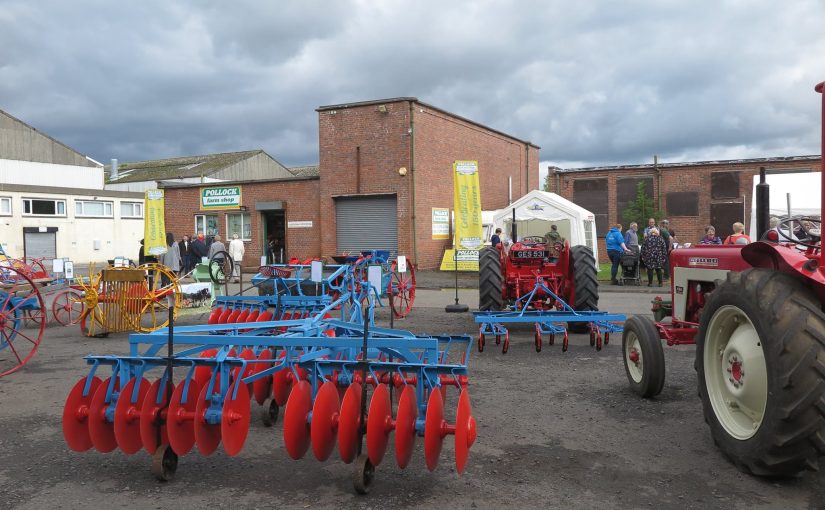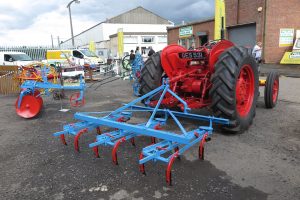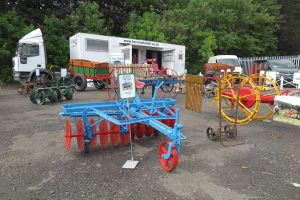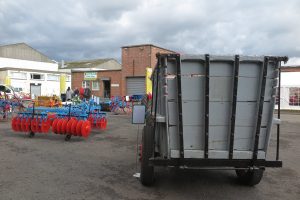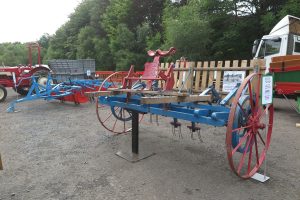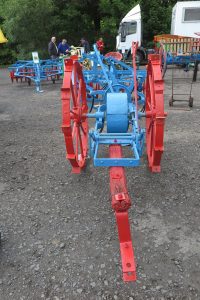Important innovations in machinery to mechanise the hay harvest took place in Lanarkshire and Ayrshire in the late nineteenth and early twentieth century. One of the makers who contributed to these important innovations was Mr Pollock of Mauchline.
This is what the North British Agriculturist wrote about Mr Pollock’s work in helping to mechanise the hay harvest, in an article published on 13 August 1914:
“Mr John Pollock and his rick lifter
During the last thirty or forty years, however, a great change has been effected in haymaking implements. With the application of the mower, horse-rake, swathe turner, tedder and hay collector, farmers have been able to cope with the much extended area of the hay crop both quicker and at a very much reduced cost for labour. The heaviest part of the work, however, is when large quantities of hay in cocks in the field has to be carted and stacked in the ordinary way, and labour has been greatly saved on this score by the combination of the horse hay fork with the rick-lifter, a system which was advocated in our columns as far back as 1887 by the late Mr John Speir of Newton and which has now become pretty general all over the country. It is perhaps not generally known that the rick-lifter or hay bogie had its origin in the Kilmarnock district of Ayrshire. The inventor was John Pollock, Park farm, Finchingfield, Essex, formerly of Middlefield, Galston, and Lathallan in Fifeshire. Although now well up in years, Mr Pollock at eighty is hale and hearty and can entertain his visitors with many experiences of his farming experiences in Ayrshire, Fife, and at Finchingfield, where he now resides on the fine arable and stock-rearing Essex farm purchased by his son last October. Mr Pollock was recently interviewed in his home by a representative of our esteemed contemporary The Kilmarnock Standard, who gives a graphic account of his visit, and thus described the origin of Mr Pollock’s great labour-saving invention.
The initial stages of invention
On such high-lying farms as Muirhead and Middlefield, the “calf-round” of the Pollocks, it can be easily understood that it did not pay to plough a large break. In consequence, more loose hay was grown than on the average farm, and the brothers, Robert and John Pollock, were fertile in plans for handling it expeditiously. They early had a mowing machine, and were among the first to erect hay sheds. To save the labour and waste attendant on forking the field ricks on to a cart they put a rope around them and drew them into the shed or hay stack with horses. By this plan stones and dirt were apt to get into the hay, with disastrous results to the chaff-cutter, and many a discussion took place between the brothers as to a plan to obviate this. Ultimately they made a sledge with trams, on to which they drew the rick with horses. This was a great step in advance, but for easiness of draught it was apparent that wheels were necessary. They added low wheels cut out of a round tree to the sledge and attached a windlass in front for pulling on the ricks, but it was not until they adopted the tipping arrangement for the platform similar to a coup-cart (which was John Pollock’s idea) that their invention was a complete success. The next year, 1879, they made a complete new rick-lifter, and it is worthy of note as showing the completeness of their invention and the thoroughness of the workmanship and materials used that this rick-lifter is still used by Mr William Pollock (son of the late Robert Pollock) at cairn, Fifeshire, and performing its work as efficiently as the newest hand-power rick-lifter made at the present day. The following year they made another, and Mr Robert Wallace of Whitletts, the noted implement maker and himself a genius, induced them to exhibit it for the public benefit on his stand at Ayr show, where it was an object of great interest. Mr John Pollock has used this one ever since.
Combination with horse-fork
To secure full advantage of the rick-lifter Mr Pollock recognised that a horse-fork was a necessity. An American horse-fork about that time was introduced into this country, but the principle on which it was made rendered it useless for anything as sold as a field rick, and it could only be worked (and even then not very satisfactorily) in loose hay. Mr Pollock saw that a fork to be of use under our conditions must be constructed on a different principle, and after several trials he devised the hay fork on the shear principle, which is invariably used in hay sheds still. About a dozen years ago he brought out another fork on the graip principle, specially suitable for hay-stacks and much speedier than the other. The builder of the stack does not require to withdraw this fork from the hay, as the attendant on the ground by simply pulling a light rope can deliver the forkful wherever the builder wants it and then pull it down for refilling. Mr Pollock with becoming modesty gives his brother Robert joint credit for the invention of the rick-lifter, and also credits his brother-in-law, the late Mr James Allan, Byres, Darvel, with giving him suggestions; but the horse-forks mentioned above, and which are the most efficient and cheapest in the market, and so simple that any blacksmith can make them, are entirely the product of his own brain. It is all to Mr Pollock’s credit that in neither the rick-lifter nor the forks did he ever seek after a patent, but allowed the public to get full benefit of his inventions.
The spread of the rick-lifter
Although the rick-lifter was recognised as a great boon it was some years before it spread rapidly. This was due to the lack of enterprise on the part of implement makers in not taking it up and pushing its sale. About 1882 a number were made at Waterside, Fenwick, by the joiner there, Mr Robert Wyllie, now in Blackbyre, and a few were also used in Avondale and elsewhere. But in 1887 both the rick-lifter and horse-fork were brought into prominence by the late Mr John Speir, Newton, who contributed a series of valuable articles on haymaking machinery to the North British Agriculturist in the summer of that year. He has used both the rick-lifter and horse-fork on his own farm the year before, and his clear and lucidly written articles, in which he described them, giving all the measurements, &c, in such a way that any intelligent tradesman could make them from it, were eagerly ready by enterprising minds all over the country. Mr Speir did not refer to the inventor of the rick-lifter, but said:-“my attention has also been taken up with a species of sledge called a rick-lifter, in very limited use in the strictly rural and in many places moorland districts lying in the counties of Lanark and Ayr between the towns of Hamilton and Kilmarnock. This hay sledge on low wheels had been in use for a year or two for conveying field ricks from the field to the stackyard. … The time required to load in the field by a man and girl is much about the same as two men require to tie the ropes and dress the side of an ordinary cart of hay, while the unloading is about the same as is required for delivering a cart of turnips from an ordinary tip or coup-cart”.
After that time nearly every country joiner commenced to make them, the farmer generally providing an old cart axle for the wheels. Large makers also began to specialise in them for both hand and horse power for drawing on the rick. Their value is now recognised, and to-day a rick-lifter is an almost indispensible part of the equipment of a hay-growing fram as is also the horse-fork.”
The photographs are of implements and machines made by Pollock of Mauchline and displayed at Pollock Farm Equipment.
